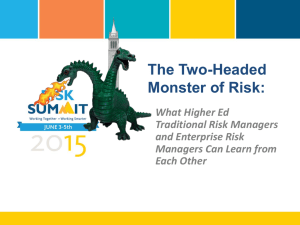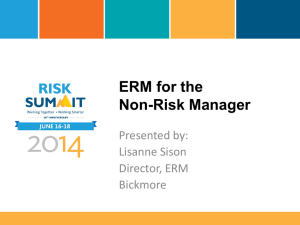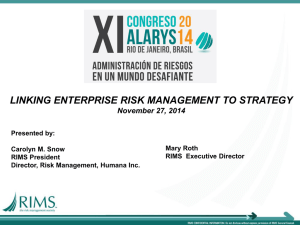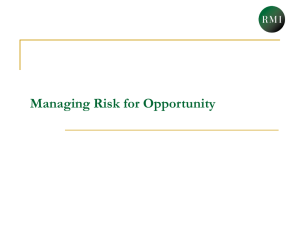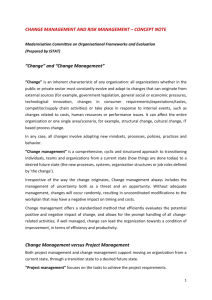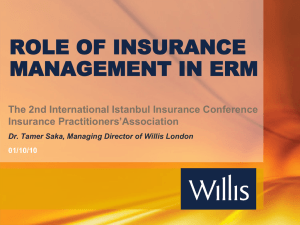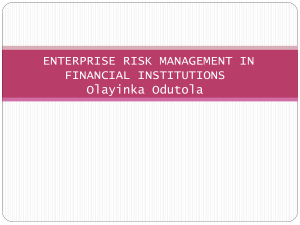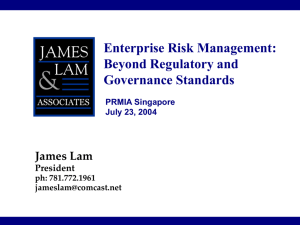International Credit Risk
advertisement
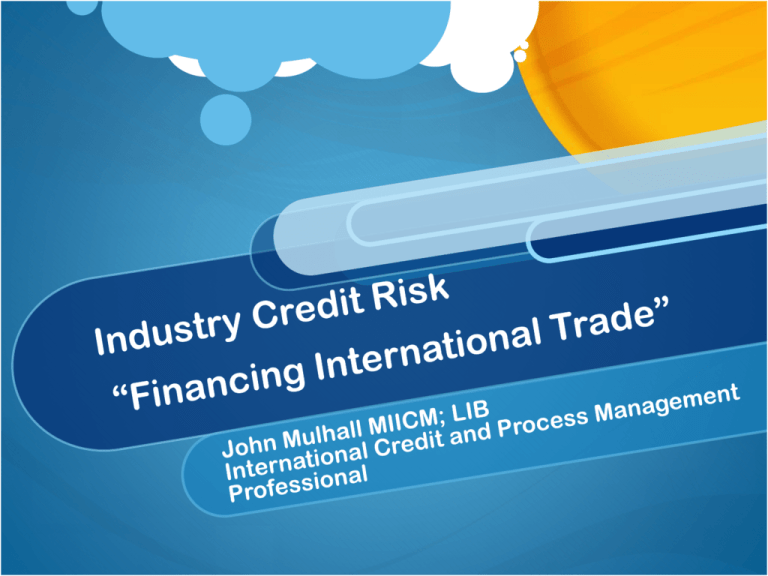
Agenda Risk – Industry Definitions Credit Risk – Its positioning Your average large company and risk Risk – Internal & External Letters of Credit Workflows Credit Risk Tools Summary Enterprise Risk Management aka “ERM” Enterprise risk management (ERM) in business includes the methods and processes used by organizations to manage risks and seize opportunities related to the achievement of their objectives. ERM provides a framework for risk management which typically involves identifying particular events or circumstances relevant to the organization's objectives (risks and opportunities), assessing them in terms of likelihood and magnitude of impact, determining a response strategy, and monitoring progress. By identifying and proactively addressing risks and opportunities, business enterprises protect and create value for their stakeholders, including owners, employees, customers, regulators, and society overall. (Wikipedia) Operational Risk A form of risk that summarizes the risks a company or firm undertakes when it attempts to operate within a given field or industry. Operational risk is the risk that is not inherent in financial, systematic or market-wide risk. It is the risk remaining after determining financing and systematic risk, and includes risks resulting from breakdowns in internal procedures, people and systems. (Investopedia) Credit Risk The risk of loss of principal or loss of a financial reward stemming from a borrower's failure to repay a loan or otherwise meet a contractual obligation. Credit risk arises whenever a borrower is expecting to use future cash flows to pay a current debt. (Investopedia) In B2B, we develop strategies to assess this on our customer portfolio bearing operational risk in mind. Risk Propensity Degree to which an entity is willing to take chances with respect to risk of loss. (businessdictionary.com) A company may not be sure of its risk propensity point until you ask, so ensure the person you seek clarification from is high enough in the organisation to define it (with you) should the propensity point not exist based on the circumstances the company operates in. Incoterms – ICC Charter 1958 Incoterms are a set of internationally recognised terms that govern the liabilities of shipments over international borders between all parties involved in a legally binding manner. First used in 1936, they were formally recognised in the International Chamber of Commerce (ICC) Treaty of 1958 and last updated in 2010. They covers areas such as shipping documentation content, party, counterparty and 3rd party liability, insurance and are used in finance instruments such as letters of credit. Popular Incoterms All Transport Modes EXW Ex Works CPT Carriage Paid To/ CIP Carriage And Insurance Paid To DAT Delivered At Terminal/ DAP Delivered At Place DDP Delivered Duty Paid Popular Incoterms Sea Transport FAS Free Alongside Ship FOB Free On Board CFR Cost and Freight CIF Cost, Insurance and Freight Enterprise Risk Management Framework “Credit Risk Positioning” Credit Risk? Heart of ERM Managing Risk Mitigating Bad Debt Loss Identifying External Threats Increasing Process Control Informing Management early Your average large company and credit risk 2011 RIMS Survey: 17% of large companies have a full formal ERM programme, 37% have a partially deployed ERM programme totaling 54% of large companies that have a full formal ERM programme. This net number is up from 36% in 2008. By extension 46% of large companies have an informal risk management programme (or none at all) which may or may not include credit risk. RIMS (Risk Management Society) Source Document http://www.rims.org/Sales/Documents/RIMS%202011%20ERM%20 Benchmark%20Survey%20final.pdf Internal Risk Process efficacy – effectiveness of business process management on a company in terms of achieving desired outcomes in a lean cost effective manner Governance – Internal controls designed to mitigate against financial and non financial risks Reporting – Identification of internal threats and the mechanism to report them into a remediation process External Risk Markets – direct/indirect risk exposure surrounding a market including market forces, changing trends, new products/services, market disrupters and new laws or regulations affecting all market players Country – direct/indirect risk exposure to a country in terms of political risk, economic risk, geopolitical shifts and future laws or regulations affecting the level of risk a company is exposed to Political Risk – The level of political risk a company is exposed to on the supply side of the business, including international footprint analysis (Plants/SSCs/Sales Offices/Indirect Presence/etc), ETOP analysis and how political shifts could alter the operating environment affecting compliance, production, supply chain and vendor management. Letters of Credit Secure form of payment in high risk counter party countries Expensive given counter party costs by the bank and Letter of Credit terms can escalate marginal costs dramatically Process MUST be defined and strong enough to process letters of credits in a defined timeframe New account opening procedures should consider letters of credit as a security option to prepaid business where high value transactions occur with the customer or are at least projected as such Letter of credit process must term based and flexible enough to handle unusual terms (e.g. 50% draw down on unit delivery, 50% 90 days after or when certificate of compliance is issued) and map the risk impact on the account, party and counter party and the company in general Letters of credit process is mainly an order management and collections process but should always have a credit risk involvement Credit Risk “Where to start?” Understand your companies “risk propensity” and managements positioning of credit risk in the organisational chart Understand the order 2 cash process for the company including its dysfunctions in great detail Understand the wishes, perceptions and concerns key stakeholders have in a credit risk service for the company. The main stakeholders are Sales and Finance management. What a good industry credit risk service should do? Aid continuity and growth by; Vetting all new credit accounts thoroughly through credit risk appraisal Periodically appraising existing accounts by customer and/or by ledger Validating and monitoring customer master-file data accuracy integrity Monitoring country risk factors for changes in exposure both direct and indirect to the companies trading presence Monitoring investment risk factors should as FX, capital markets and macroeconomic shifts (inflation, etc.) Provide expert advise and input to any project and/or systems based initiative that has a credit risk element Control, report and action internal process controls surrounding credit risk and data accuracy Workflow Description New Customer Account Opening CR1 Application form completed fully – CR2 Rep gets management discounts and set up approvals – CR3 Credit Report from 3rd party Vendor (e.g. D&B) is ordered CR4 Verification of ALL relevant and legally important information as correct – CR5 Verification of confirmed details as set up on the customer master-file CR6 A financial risk appraisal on the customer is done concentrating on solvency, liquidity and asset profile CR7 The country risk exposure analysis is performed - CR8 A credit risk opinion of the proposition based on terms and credit limit sought is formed CR9 Submitted for approval in line with company policy – CR10 Account trading line opened. CR11 Documents filed in line with company policy Workflow – New Account Set up Workflow - Ledger Risk Evaluation Aged Debt by Invoice Analyzed Invoices past due total and ageing to Risk Score (test for score accuracy to policy) Credit Invoices open to Debit Invoices (evaluate pattern for cash allocation process issues which have collection effect) Returned Payments Analysis Country Risk analysis on high value accounts Individual Risk analysis over certain account balance value based on a process like the “new account opening” process detailed in this session Report with findings on internal and external risk indicators prepared and sent to management including red flagged accounts with recommendations Month End Controls… Master-file Data Changes – Reconcile Customer Account Changes to Approved Control Registers of Change and Set up Country Risk Report Summary – Summary Report of Risk Highlights on all territories that company has an exposure to Internal Risk Report – Report on months internal risk and controls issue findings External Risk Report – Report on months external risk findings Customized reporting can be generated under this top line reporting line once it creates value through informing management or prompting follow on actions in a control environment. Credit Risk Tools.. Bloomberg Company Search Credit Risk Tools… The Country Risk Report.. Summary – Overall Score Macroeconomic Indicator Summary (e.g. GDP/GNP/Payment performance/Business Summary) Geo political movements/updates (e.g. New elections/alliances/pledges such as crackdown on political corruption/etc.) Trading movements/updates (e.g. Import/Export trading status report/FX trading report) New laws or regulations of note (e.g. new FX Controls) Relevant News to Business Recommendations Credit Risk Tools… The Credit Report Customer details (confirmed) Customer legal/regulatory status report Customer payment record Customer financial records Customer reports/ media reports Score and risk opinion Summary Manage, mitigate and report!!! Processes should be creating value by the information that is collected, collated and reported upon Integrity of financial and non financial risks should be monitored consistently through the credit risk process structure Accounts should be credit risk appraised at least every 3 years, with high value accounts appraised annually Process improvement and alteration is a must as the quality of information inwards determines the quality of information outwards Cost effective processes are only “effective” if they add value. Justify all expenditures in value terms for what they do and what they prevent/mitigate Be professional, insightful and diligent Thank you for your time…




